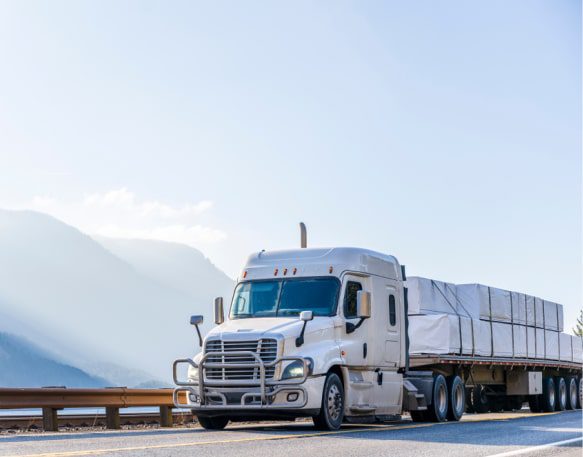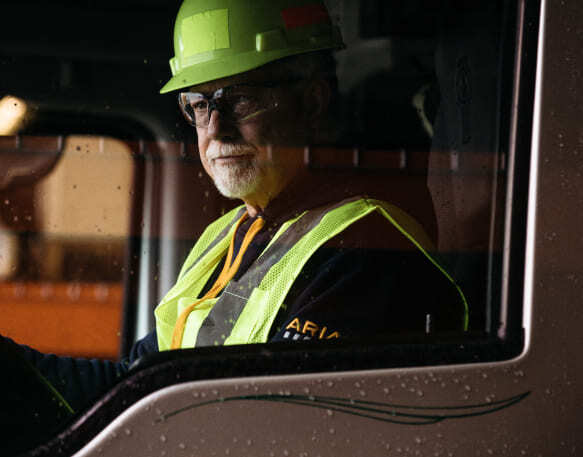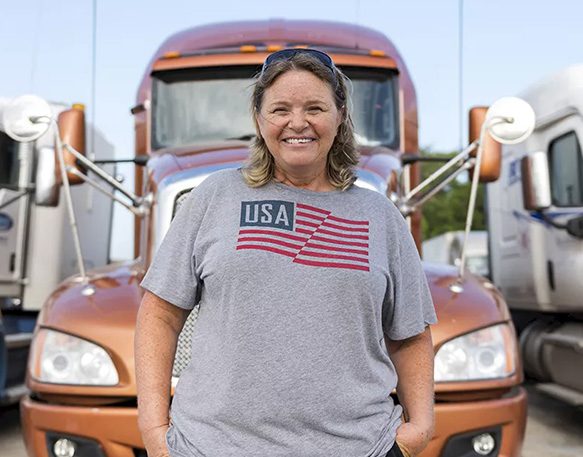Flatbed trucking can be one of the most profitable, albeit risky, types of trucking for carriers and owner-operators.
Unlike your typical dry vans or refrigerated trucks, which carriers can use to haul a wide variety of standard, bread-and-butter freight, flatbeds often transport specialized cargo. Even though most flatbeds are usually open-deck, you’ll find some flatbeds like Conestogas are enclosed. Either way, driving a flatbed can be more challenging than driving other types of vehicles because flatbed loads always need to be secured by the driver.
However, for many, flatbed trucking offers many rewards that make it a perfect fit. To determine whether flatbed trucking is right for you — and to ensure you’re set up for success if you do choose to start flatbed hauling — we’ve put together the ultimate guide to flatbed trucking.
In this ultimate guide to flatbed trucking, we’ll cover all of the burning topics surrounding flatbed trucking and answer key questions, like:
- What is a flatbed truck?
- What is flatbed trucking?
- What are flatbed trucking rates?
- What are the dimensions of popular flatbed trucks?
- How do I safely secure flatbed loads?
- How do I get my operating authority?
- How do I find the best flatbed loads?
What is a flatbed truck?
Before diving into the specifics of flatbed trucking, it’s important to first recognize some of the defining characteristics that distinguish flatbed trucks from other vehicles. Designed to haul a variety of oversized cargo, flatbed trucks pull trailers that come with flat bodies and without any sides or roofs. Given their distinct bed design, flatbed trucks are well-suited to safely haul loads that might be too wide for enclosed trucks. The unique deck of a flatbed also simplifies the loading and unloading process, since forklifts can be easily maneuvered from any side of the truck.
Flatbeds are typically equipped with a robust aluminum frame, and they often have a wooden floor to provide additional support. In some instances, flatbed truck trailers may be connected together to transport exceptionally oversized loads.
What is flatbed trucking?
Flatbed trucking within the freight industry often refers to the hauling of tall, oversized or wide-load cargo. Flatbed trucking trailers typically measure approximately 102 inches wide and 53 feet long. While loads that are unable to securely fit within an enclosed vehicle are often earmarked for flatbed trucks, flatbed trucking can also involve the transportation of normal sized freight.
Flatbed trucks are noted for their versatility – you’ll often see flatbeds with multiple trailer combinations. Given the unique characteristics and capabilities of flatbed trucks, it’s no surprise that many industries that require the transportation of large and heavy materials have turned to flatbed trucking. At any one time, a flatbed truck driver might find themselves working with:
- Agricultural goods and equipment
- Building materials
- Construction equipment
- Lumber
- Heavy machinery
- Oil and gas rigs
- Roofing pallets
- Scrap metal removal and recycling
What are flatbed trucking rates?
An appealing aspect of flatbed trucking is that shippers will typically pay carriers higher rates to haul flatbed cargo compared to other types of freight. That’s because flatbed truckers require a high degree of skill when hauling larger flatbed cargo in order to navigate the heightened dangers this freight presents. In addition, flatbed truckers must abide by the DOT’s stringent rules and regulations.
Of course, flatbed rates ultimately vary based on a variety of factors. The kind of freight being transported, the market in question, and the general pressures of larger market forces, especially supply and demand, are just a few variables that will inevitably influence the rate you secure for each new flatbed job.
With that in mind, flatbed rates range between $2.71 to $3.30 per mile on average with the national average rate presently coming out to roughly $3.07 per mile. To put that number into context, the current national per-mile rate for dry van jobs averages out at $2.27, meaning that flatbed trucking pays an average of 80 cents more per mile compared to dry van trucking. That difference means that flatbed drivers across the country can gross upwards of $15,000 more than their counterparts driving other vehicles.
It’s important to note that while flatbed trucking may offer higher rates and revenues, that doesn’t necessarily mean higher profits. Compared to regular dry vans, flatbed drivers typically face steeper expenditures. Flatbed loads are generally less fuel efficient, and flatbed truckers are more likely to drive deadhead miles in search of their next load.
What are the dimensions of popular flatbed trucks?
As mentioned, the standard dimensions of an ordinary flatbed measure roughly 53 feet long and about 102 inches wide, but there are flatbeds of many different dimensions available for you to choose from. If you’re looking to expand your fleet, it’s important to consider your options and assess the various kinds of flatbed trailers that are on the market in the context of your business needs. Here are a few of the most popular types of flatbed trailers you might come across:
- Double drop – Double drop flatbed trucks can be useful for transporting tall freight that measures more than 10 feet in height. In addition to front and back decks, flatbed trailers are built with a well in the middle. The well, which typically stretches between 25 to 29 feet long, enables double drop flatbed trucks to securely haul tall cargo over long distances. But note: a double drop’s well naturally eats into a flatbed truck’s interior capacity, meaning it can create challenges if you aren’t transporting tall freight. It’s also worth mentioning that double drop flatbeds require cranes and additional flatbed equipment to safely load and unload cargo.
- Dimensions (Main Deck, or well):
- Height: 11 feet, 6 inches
- Length: 25 feet to 29 feet
- Width: 8 feet, 6 inches
- Dimensions (Front Deck):
- Height: 8 feet, 6 inches
- Length: 10 feet
- Width: 8 feet, 6 inches
- Dimensions (Rear Deck):
- Height: 10 feet
- Length: 9 feet
- Width: 8 feet, 6 inches
- Dimensions (Main Deck, or well):
- Extendable flatbeds – Sometimes known as flatbed stretch trailers, extendable flatbeds are often used to haul items that are too long to fit securely onto a normal flatbed. Extendable flatbeds allow owner-operators to efficiently transport cargo and eliminate any overhang. It should be noted, however, that in some cases additional permits might be required in order to haul the largest loads legally.
- Dimensions:
- Height: 8 feet, 6 inches
- Width: 8 feet, 6 inches
- Minimum length: 48 feet
- Maximum length: 80 feet
- Maximum cargo weight: 43,000 lbs
- Dimensions:
- Side-kit – Equipped with curved bow-like metal spines, flat panels, and stakes surrounding the bed’s perimeter, side-kit flatbed trailers give carriers all the component parts necessary to create a structure that can connect to a tarp. A side-kit’s added tarp functionality proves highly valuable when transporting delicate cargo or otherwise precarious loads that need to remain dry and safely protected from the elements.
- Dimensions:
- Height: 8 feet, 8 inches
- Width: 8 feet, 4 inches
- Length: 8 feet, 6 inches
- Maximum cargo weight: 45,000 lbs
- Dimensions:
- Step deck – A step deck, also referred to as a drop deck, is a type of flatbed trailer that contains both a top and bottom deck. Step deck flatbed trailers can be another great option if you regularly find yourself with loads that are too tall or wide to be stowed securely into a regular flatbed truck. Since step deck flatbed loads often occupy a lower position in the trailer, step decks can usually traverse low bridges without any problems – even when hauling taller freight. When you arrive at your destination and are ready to unload, loading ramps allow personnel to easily access the bed at ground level.
- Dimensions:
- Bottom deck height: 10 feet
- Bottom deck length: 37 feet
- Top deck length: 11 feet
- Width: 8 feet, 6 inches
- Maximum cargo weight: 48,000 lbs
- Dimensions:
How do I safely secure flatbed loads?
From the loading to unloading phase, one of your primary responsibilities as a carrier or owner-operator is to ensure your cargo remains safe and secure at all times. While the safety of personnel and property remains paramount across any line of freight, carriers can sometimes encounter additional challenges when it comes to physically securing oversized flatbed loads.
As far as the best securement devices for flatbed loads, most flatbed carriers typically use nylon straps or chains with binders. When taking on a new flatbed job, however, you should first consider whether the cargo needs to be shielded from Mother Nature’s elements. In cases where you’re transporting sensitive flatbed cargo that needs to remain dry, a 6ft or 8ft drop tarp, Conestoga, or Rolltop should do the trick. In rare cases, a speciality tarp or 4ft drop tarp may be more appropriate for your needs.
Once you determine your load’s characteristics and flatbed equipment needs, consider a few simple rules of thumb to ensure your cargo remains safe and secure throughout your freight journey, such as:
- Distributing the weight of the cargo evenly – After you identify the flatbed load’s size/weight, before loading, the first step for a driver is to determine where the center of the trailer is. Keep in mind that unlike vans or reefers, flatbed trailer tandems do not slide.In order to properly secure your cargo, you should also determine how the height of the load impacts the load capacity of your straps or chains. As a general rule of thumb, the closer your freight is to the flatbed deck, the less load capacity your securement will have. To ensure you’re never going above the listed weights, divide the cargo’s total weight by the load capacity of an individual strap or chain.
- Scanning how the cargo is positioned on the flatbed trailer – When you pick up a new flatbed load, the cargo, at minimum, should be stowed with two inches between each item and the side of the trailer. If your items are delicate and run the risk of being damaged by chains with binders, your best option may be to tie two straps over your goods. However, DOT regulations mean that you may not be able to replace chains with straps in many cases, so make sure to check the appropriate regulations before you make the switch. If you’re transporting freight that won’t be damaged by chains, your best strategy is typically to secure your cargo using two chains with binders.
- Routinely monitoring that the flatbed cargo stays securely tied down – During the loading phase, before tightening the chains or straps, in order to prevent freight damage, it’s wise to cover the edges of your cargo with some carpet scraps. If you’re using nylon straps to tie down your cargo, thread the hooked end of both straps through the outer safety rail. With your cargo now affixed to the underframe, you should have no problem throwing the rolled up straps over the freight.
How do I get my operating authority?
Before you can start worrying about securing your flatbed freight, you first need to get your operating authority to be able to transport goods using your flatbed truck legally. And that’s not all. To legally operate flatbed trucks, due in part to the hazards associated with flatbed trucking, carriers must comply with a series of strict safety rules and regulations outlined by the Department of Transportation (DOT) and other governing agencies.
Fortunately, you don’t need to navigate the process of getting operating authority (which involves everything from getting your DOT and MC numbers, to finding BOC-3 processing agents, to getting appropriate insurance) or understanding these rules and regulations alone. The experts at DAT Authority can guide you through the entire process, ensuring that you can start operating your flatbed trailer as soon as possible.
Whether it’s correctly registering your DOT paperwork, ensuring your licenses and permits remain active and up-to-date in every state you operate in, or relieving you of additional administrative back-office burdens, DAT Authority has got you covered.
How do I find the best flatbed loads?
Load boards are the easiest and most efficient way to find new, high-quality flatbed freight. But be warned: not all load boards are created equal – especially when it comes to sourcing high-quality flatbed loads and other kinds of specialty freight.
The freight market is flooded with load boards – some charge a fee, others are free – so it can be difficult to sort through your options. While you may be tempted to go with a free load board, it is unlikely to be the best way to find the freight that helps move your business forward. Instead turn to a paid board that simplifies your load-finding process, unlocks new business opportunities, and drives profitability to new levels.
The DAT load board does all that and more, which is why DAT has emerged as carriers’ go-to source for finding the most lucrative flatbed loads. Carriers tap into DAT One, the largest digital, on-demand freight marketplace in North America, to work with best-in-class partners, win new business, and boost bottom-lines.
If you’re a carrier or owner-operator aiming to grow your flatbed business and stay ahead of the competition, joining DAT One is a no-brainer. DAT members leverage an array of cutting-edge tools, up-to-the-minute analytical insights, and a trove of value-add freight resources to thrive in fast-moving freight markets. Through the free DAT One mobile app, you can login to DAT’s load board from anywhere, instantly match to the best flatbed loads, and keep your fleet on the open road. Start finding the best loads for your flatbed business today with the DAT load board!
Find the best flatbed trucking freight with DAT!
Join DAT One today to become part of the most popular and active freight network in North America. DAT offers load board packages at affordable, flat monthly rates with no hidden fees. Run searches, post your truck, set alerts, and more to find the best freight opportunities for your business. Try it today!




